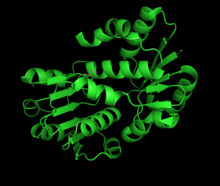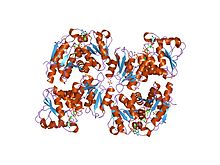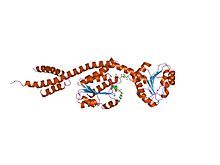Shikimate dehydrogenase
| Shikimate Dehydrogenase | |||||||||
|---|---|---|---|---|---|---|---|---|---|
 |
|||||||||
| Identifiers | |||||||||
| EC number | 1.1.1.25 | ||||||||
| CAS number | 9026-87-3 | ||||||||
| Databases | |||||||||
| IntEnz | IntEnz view | ||||||||
| BRENDA | BRENDA entry | ||||||||
| ExPASy | NiceZyme view | ||||||||
| KEGG | KEGG entry | ||||||||
| MetaCyc | metabolic pathway | ||||||||
| PRIAM | profile | ||||||||
| PDB structures | RCSB PDB PDBe PDBsum | ||||||||
| Gene Ontology | AmiGO / EGO | ||||||||
|
|||||||||
| Search | |
|---|---|
| PMC | articles |
| PubMed | articles |
| NCBI | proteins |
| Shikimate dehydrogenase, N terminal domain | |||||||||
|---|---|---|---|---|---|---|---|---|---|

Shikimate dehydrogenase AroE complexed with NADP+
|
|||||||||
| Identifiers | |||||||||
| Symbol | Shikimate_dh_N | ||||||||
| Pfam | PF08501 | ||||||||
| InterPro | IPR013708 | ||||||||
| SCOP | 1vi2 | ||||||||
| SUPERFAMILY | 1vi2 | ||||||||
|
|||||||||
| Available protein structures: | |
|---|---|
| Pfam | structures |
| PDB | RCSB PDB; PDBe; PDBj |
| PDBsum | structure summary |
| Shikimate Dehydrogenase C terminal | |||||||||
|---|---|---|---|---|---|---|---|---|---|

Glutamyl-tRNA reductase from methanopyrus kandleri
|
|||||||||
| Identifiers | |||||||||
| Symbol | Shikimate_DH | ||||||||
| Pfam | PF01488 | ||||||||
| Pfam clan | CL0063 | ||||||||
| InterPro | IPR006151 | ||||||||
| SCOP | 1nyt | ||||||||
| SUPERFAMILY | 1nyt | ||||||||
|
|||||||||
| Available protein structures: | |
|---|---|
| Pfam | structures |
| PDB | RCSB PDB; PDBe; PDBj |
| PDBsum | structure summary |
In enzymology, a shikimate dehydrogenase (EC 1.1.1.25) is an enzyme that catalyzes the chemical reaction
Thus, the two substrates of this enzyme are shikimate and NADP+, whereas its 3 products are 3-dehydroshikimate, NADPH, and H+. This enzyme participates in phenylalanine, tyrosine and tryptophan biosynthesis.
Shikimate dehydrogenase is an enzyme that catalyzes one step of the shikimate pathway. This pathway is found in bacteria, plants, fungi, algae, and parasites and is responsible for the biosynthesis of aromatic amino acids (phenylalanine, tyrosine, and tryptophan) from the metabolism of carbohydrates. In contrast, animals and humans lack this pathway hence products of this biosynthetic route are essential amino acids that must be obtained through an animal's diet.
There are seven enzymes that play a role in this pathway. Shikimate dehydrogenase (also known as 3-dehydroshikimate dehydrogenase) is the fourth step of the seven step process. This step converts 3-dehydroshikimate to shikimate as well as reduces NADP+ to NADPH.
This enzyme belongs to the family of oxidoreductases, specifically those acting on the CH-OH group of donor with NAD+ or NADP+ as acceptor. The systematic name of this enzyme class is shikimate:NADP+ 3-oxidoreductase. Other names in common use include:
...
Wikipedia
